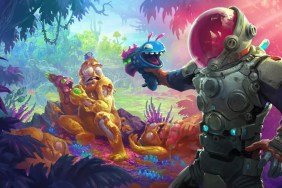Twisted Lore
nce upon a time, a fragile little girl named Ellen lost her parents, a common enough tragedy in fairy tales. Then at the uncertain age of twenty-two, she receives a mysterious letter addressed from no one other than her own mother. Grasping the envelope tightly to her chest, she quickly flutters off with the conviction to find a boat and reach Doolin Village, a quaint, rundown hamlet on the island that ship captains dare never to sail. But she gathers whatever courage she has, however small, and pleading with her gentle voice, convinces a hardened seafarer to get her to the cursed isle. There, in “The Land of the Dead”, she may find the truth of all that she has lost.
[image1]Heartwarming, isn’t it? It’s this kind of prologue, simple but uncompromising, that pulls me into a Disney or Miyazaki film more than anything else. Like turning the first page of a fantasy children’s book, I want to be engrossed in a magical world, caught by the imagination of its creatures and lands without having to interpret symbolic references, camera angles, and erudite allusions.
And what a world Folkore is. Just Doolin Village – a hauntingly quiet town surrounded by cobbled stone, rolling hills, jagged cliffs, and humble eeriness – is incredibly imagined, as if it was a hidden secret kept silent off the coasts of England. A serene but troubled piano solo filled with natural tones and chords plays in the background, lulling and luring you to discover its secrets and relieve the maritime village of its melancholy.
Conversely, visit the pub at nighttime and you will be greeted by the fiddling of magical folk who can only be seen by you: a disheveled, twitchy rat whose robes and hat are far too big for him; a steel robot with a scarf and two steam-pipe heads; and a tall, pipe-smoking hairball that looks like Cousin It on steroids. This unrestrained creativity extends into the Netherworld – a parallel world made of supernatural realms, of faeries, wars, seafolk, and endless corridors. Apart from the occasional looping track of battle music, the visual and aural presentation is as striking and enchanting as that of Pan’s Labyrinth.
Regrettably, that’s where the comparison ends.
Folklore is a beautiful, intricate, and interesting mess. What it has in originality and high-budget productions, it lacks in cohesion and execution. This doesn’t mean it ever stops being beautiful, intricate, and interesting – like Nariko’s hair in Heavenly Sword – but more care and refinement should have been given to the essentials: the story and the gameplay.
[image2]Adding another layer to the plot is Keats, a reporter for a second-rate occult magazine who receives a mysterious phone call from a woman in Doolin Village, claiming that faeries will kill her. Within a day of hunting for clues, he witnesses Ellen beneath a relic called The Henge (two guesses as to whether it’s made of stone) donning a sacred cloak and becoming a Messenger that can travel freely between the real world and the Netherworld. His curiosity pays off, and Keats gains this power as well just by being near her when the cloak activates, but he too is sucked into the girl’s hunt for her mother – quite literally.
Control alternates between the hopeful teenager and the skeptical journalist, essentially requiring you to complete each chapter with both. The plot interweaves the story arcs of the duo, contrasting different points of view on the same events in much the same way Suikoden III does – but not as richly. Even assuming that the original concept design was to have two main characters on the same plotline, much is sacrificed for the sake of it and it ends up just not working.
Part of this comes from the dialogue, which though interesting and occasionally deep, is muddled and erratic. It’s so busy trying to organize itself in an unusual way that it forgets to be clear. Characters use pronoun references and inferences with such frequency that they eventually become the only ones who know what is going on. Often, the main character will ask a question, and then the person you’re asking will answer with another question or with an answer to a different question, and then the current question is forgotten until it’s answered later. For instance, Ellen asks a boy where Dr. Lester is by saying “Dr. Lester?” and then the boy begins his response with “The Netherworld is a land of the dead…” Did you get all that, Yoda?
The story turns into an awkward test of interpretation and reading comprehension, which feels like having to interact with Jeff Goldblum for more than ten seconds. Just talking to the villagers is a pain. You know that some of them can answer your questions clearly and completely, but they give only half of the truth, and that’s only if you understand them in the first place. Characters habitually spout out an “I see…”, “I understand…”, or “So it must be true…” kind of sentence, when you have no idea what they just saw, understood, or believe is true with all their heart. It’s just irritating moving through a story that’s only too happy keeping its secrets no matter how many enemies you slay. Even Ellen gets fed up with a woman in a wheelchair: “Well, what on Earth is wrong with telling me!?!”
[image3]More confusing is that scenes switch between full-motion videos with voice acting and floating comic-book panels with text bubbles. Having to flip-flop from one medium to another is schizophrenic. Me and I agree. There really isn’t much excuse for not having full voice acting on the Playstation 3.
Questioning the need for two main characters further is that there’s not much difference in how they play. Every chapter begins by finding a momento of a dead person to open a realm, then defeating low-level folk, using low-level folk to defeat higher-level folk, using higher-level folk to defeat the boss Folklore, and then returning to the village for some (confusing) story advancement and another momento. A few changes are made to mix up the formula for the pair: Ellen can become one with Barbie and change her cloaks, and Keats can transform into an invincible, laser-eyed, white-haired badass. They also have to collect somewhat different sets of “Folkémon” (there just aren’t any “Folkeballs”), employ somewhat different strategies for bosses, and converse with somewhat different people. But these are all minutiae compared to the grand gotta-catch-‘em-all scheme.
In fact, it feels like Folklore wanted to let go of the two-character idea but couldn’t. According to the story, Keats is supposed to be a Guardian for Ellen, but for the most part, he isn’t around to protect her by way of design. Unfortunately, the game ends up having to justify how Ellen and Keats hardly ever meet other in the Netherworld even though they enter the same world at nearly the same time going down the same path. Supposedly, it has something to do with how time and space gets distorted when two different psyches are predisposed to the… yeah, whatever. Worse, Ellen and Keats don’t share anything, which means that you’ll have to level up two similar sets of “Folkémon” (say, Leaf-Pearl and Fire-Diamond) while you’re frolicking through the same world twice.
This super-sized amount of gruntwork means that you’re likely pass on quests, downloadable quests, and releasing karma for your various “Folkémon”. Satisfying certain conditions generally improves your folk – higher attack power, lower mana consumption, combo additions, and such – but there is no enticing incentive to do so. Most enemies aren’t too difficult to defeat, and scattered about the land are pages of picture books, innovative pictorial hints that show you the weaknesses of high-level folk and bosses. Most folk are used once and forgotten anyway. Without any generous rewards such as sizeable experience bonuses for releasing karma, collecting karma-related items – the only kind – doesn’t matter much. And since it takes hours to level up, level-grinding isn’t worth the time.
[image4]Folklore, however, isn’t a disposable title. Its flaws are just as complicated to describe as it is to wrap your head around what they are in the first place. You will spend a healthy amount of exploring, summoning beasts of burden, and gathering new folk and picture book pages. And despite the convoluted dialogue, you’ll want to move onto the next realm, if only to piece together what the hell is happening. As Keats admits: “I want to hear the story more than I want that Folklore thing, but still…”
It’s too easy to say not to judge a book by its cover. Though the saying mostly fits in this instance, Folklore is better than most titles you’ll find in the land of the dead called the bargain bin. No part of its design is disastrous, just unfocused. I can still appreciate what it tries to do, even while I complain about how it’s executed. If you’re someone who pines for originality and risk-taking, then Folklore is a tale worth flipping through.
-
Creative, well-modeled graphics
-
Haunting but pleasant soundtrack
-
Picture books
-
Interesting storyline
-
...but difficult to grasp and sort
-
Redundant gruntwork
-
Folkémon
-
Overwrought











